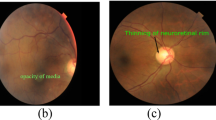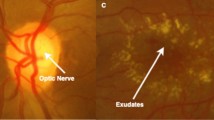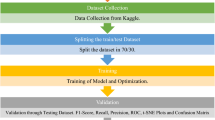Abstract
Background: Prevalent, preventable or treatable causes of blindness include Diabetic Retinopathy (DR), Glaucoma, Cataract and Optic Nerve Head Swelling. Community screening camps are routinely conducted to mainly screen for these diseases/conditions. This is crucial for maintaining good vision and preventing irreversible damage that can lead to blindness. Screening is for early diagnosis, to ensure further investigations and prompt treatment to save vision. The use of intelligent systems to assist the healthcare professionals can help speed up the diagnostic process.
Methodology: Retinal fundus images (RFI) can be used to diagnose several ocular diseases including diabetic retinopathy, glaucoma, cataract and optic nerve head swelling. After preprocessing, the RFI can be classified by trained Neural Networks to detect these diseases. We have curated a dataset with 5600 images in 5 classes and used it to train, validate and test our Ocular Disease Detection System (ODDS). ODDS uses the EfficientNet-B3 model for image classification.
Results: The ODDS performs well with a testing accuracy of 93%. Other performance metrics including precision, recall and F1-scores are also high for all the classes.
Conclusion: The Ocular Disease Detection System (ODDS) will be very useful in community screening programmes and in remote or rural regions. Although the outcomes achieved are highly promising, augmenting the amount of training data from a range of different sources would make the system robust and enhance the practical applicability of the system. The possibility of utilising smartphones equipped with an appropriate lens assembly to record RFI should be explored. This will reduce costs and increase the accessibility of the system.
Access this chapter
Tax calculation will be finalised at checkout
Purchases are for personal use only
Similar content being viewed by others
References
Benet, D., Pellicer-Valero, O.J.: Artificial intelligence: the unstoppable revolution in ophthalmology. Surv. Ophthalmol. 67(1), 252–270 (2022)
Wang, Z., Keane, P.A., Chiang, M., Cheung, C.Y., Wong, T.Y., Ting, D.S.W.: Artificial intelligence and deep learning in ophthalmology. In: Lidströmer, N., Ashrafian, H. (eds.) Artificial Intelligence in Medicine, pp. 1519–1552. Springer, Cham (2022). https://doi.org/10.1007/978-3-030-64573-1_200
Shigueoka, L.S., Jammal, A.A., Medeiros, F.A., Costa, V.P.: Artificial intelligence in ophthalmology. In: Lidströmer, N., Ashrafian, H. (eds.) Artificial Intelligence in Medicine, pp. 1553–1566. Springer, Cham (2022). https://doi.org/10.1007/978-3-030-64573-1_201
Malini, A., Priyadharshini, P., Sabeena, S.: An automatic assessment of road condition from aerial imagery using modified VGG architecture in faster-RCNN framework. J. Intell. Fuzzy Syst. 40(6), 11411–11422 (2021)
Anton, N., et al.: Comprehensive review on the use of artificial intelligence in ophthalmology and future research directions. Diagnostics 13(1), 100 (2022)
Zhou, H.: Design of intelligent diagnosis and treatment system for ophthalmic diseases based on deep neural network model. Contrast Media Mol. Imaging 2022 (2022)
Vedula, S.S., Tsou, B.C., Sikder, S.: Artificial intelligence in clinical practice is here—now what? JAMA Ophthalmol. 140(4), 306–307 (2022)
Jeong, Y., Hong, Y.J., Han, J.H.: Review of machine learning applications using retinal fundus images. Diagnostics 12(1), 134 (2022)
Li, B., et al.: Development and evaluation of a deep learning model for the detection of multiple fundus diseases based on colour fundus photography. Br. J. Ophthalmol. 106(8), 1079–1086 (2022)
Müller, D., Soto-Rey, I., Kramer, F.: Multi-disease detection in retinal imaging based on ensembling heterogeneous deep learning models. In: German Medical Data Sciences 2021: Digital Medicine: Recognize–Understand–Heal, pp. 23–31. IOS Press (2021)
Cen, L.P., et al.: Automatic detection of 39 fundus diseases and conditions in retinal photographs using deep neural networks. Nat. Commun. 12(1), 1–13 (2021)
Guo, C., Yu, M., Li, J.: Prediction of different eye diseases based on fundus photography via deep transfer learning. J. Clin. Med. 10(23), 5481 (2021)
Pandey, P.U., Ballios, B.G., Christakis, P.G., et al.: An ensemble of deep convolutional neural networks is more accurate and reliable than board-certified ophthalmologists at detecting multiple diseases in retinal fundus photographs. Br. J. Ophthalmol. (2023). https://doi.org/10.1136/bjo-2022-322183
Prasanna, P., et al.: Indian diabetic retinopathy image dataset (IDRiD). IEEE Dataport (2018). https://dx.doi.org/10.21227/H25W98
Budai, A., Bock, R., Maier, A., Hornegger, J., Michelson, G.: Robust vessel segmentation in fundus images. Int. J. Biomed. Imaging 2013 (2013)
Machine Learning for Pseudopapilledema dataset. https://osf.io/2w5ce/, https://doi.org/10.17605/OS-F.IO/2W5CE
Tan, M., Le, Q.: Efficientnet: rethinking model scaling for convolutional neural networks. In: International Conference on Machine Learning, pp. 6105–6114. PMLR (2019)
https://keras.io/api/applications/efficientnet/. Accessed 19 Dec 2022
Pujari, A., et al.: Clinical role of smartphone fundus imaging in diabetic retinopathy and other neuro-retinal diseases. Curr. Eye Res. 46(11), 1605–1613 (2021)
Gupta, S., Thakur, S., Gupta, A.: Optimized hybrid machine learning approach for smartphone based diabetic retinopathy detection. Multimed. Tools Appl. 81(10), 14475–14501 (2022)
Nakahara, K., et al.: Deep learning-assisted (automatic) diagnosis of glaucoma using a smartphone. Br. J. Ophthalmol. 106(4), 587–592 (2022)
Author information
Authors and Affiliations
Corresponding author
Editor information
Editors and Affiliations
Rights and permissions
Copyright information
© 2023 The Author(s), under exclusive license to Springer Nature Switzerland AG
About this paper
Cite this paper
Thiagarajan, P., Suguna, M. (2023). Deep Learning Ocular Disease Detection System (ODDS). In: Kadry, S., Prasath, R. (eds) Mining Intelligence and Knowledge Exploration. MIKE 2023. Lecture Notes in Computer Science(), vol 13924. Springer, Cham. https://doi.org/10.1007/978-3-031-44084-7_21
Download citation
DOI: https://doi.org/10.1007/978-3-031-44084-7_21
Published:
Publisher Name: Springer, Cham
Print ISBN: 978-3-031-44083-0
Online ISBN: 978-3-031-44084-7
eBook Packages: Computer ScienceComputer Science (R0)




